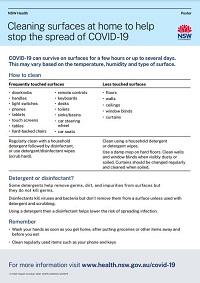
Hygiene advice for people living in residential buildings

Cleaning surfaces at home to help stop
the spread of COVID-19
COVID-19 and surfaces
Studies suggest that coronaviruses (which includes the COVID-19 virus) may be able to survive on surfaces for a few hours or up to several days. Coronaviruses on surfaces can be killed through cleaning and disinfection. While cleaning is important, the risk of transmission from a contaminated surface is much lower compared to having close contact with a COVID-19 case.
Cleaning frequently touched surfaces
Regularly clean these surfaces with a household detergent, followed by disinfectant. Alternatively, you can use detergent/disinfectant wipes as long as you scrub the surface hard:
- doorknobs
- handles
- light switches
- phones
- tablets
- touch screens
- tables
- hard-backed chairs
- remote controls
- keyboards
- desks
- toilets
- sinks/basins
- car steering wheel
- car seats.
Cleaning less touched surfaces
For general surfaces, using a household detergent solution/wipes for cleaning is adequate:
- floors (use a damp mop rather than dry mopping hard floors)
- walls (clean when visibly dusty or soiled)
- ceilings
- window blinds (clean when visibly dusty or soiled)
- curtains (change regularly in addition to cleaning when soiled).
What is the difference between detergent and disinfectant?
Detergents help remove germs, dirt, and impurities from surfaces. By removing them it lowers their numbers and the risk of spreading infection.
Disinfectants are chemical solutions that are designed to ‘kill’, but not remove, viruses and bacteria. Disinfectants do not necessarily clean dirty surfaces or remove germs, but by killing germs on a surface after cleaning, it can further lower the risk of spreading infection.
What can I use if I don’t have disinfectant?
For hard, non-porous surfaces, a diluted household bleach solution can be used in a ratio of four teaspoons of bleach per one litre of water.
Importantly, never mix household bleach with ammonia or any other cleaner. You need to check the product is not past its expiration date, which makes it ineffective. You must also ensure good ventilation of the area during and after application.
Arriving home after being outside
Remember:
- wash your hands as soon as you get home, after putting groceries or other items away and before you eat
- clean regularly used items such as your phone and keys.
Hygiene advice for people living in residential buildings
People living in residential buildings should take care when moving through common areas to reduce the risk of COVID-19:
- Clean your hands with soap and water for 20 seconds or use an alcohol-based hand rub/sanitiser after touching any frequently touched surfaces in common areas. This includes doorknobs or door handles when you enter and exit the building or when using communal washing machines or dryers
- Cover your nose and mouth with a tissue when coughing and sneezing or use your elbow, not your hands
- Avoid close contact with people unwell with cold or flu-like symptoms
- Avoid touching your face and avoid shaking hands with others
- Try to maintain a distance of 1.5 metres from others as much as possible in your apartment block, such as in elevators, stairwells or hallways.
Cleaning guidance for NSW strata managers and body corporates
- Regularly clean frequently touched surfaces in common areas with a detergent followed by disinfectant, or use detergent/disinfectant wipes
- Consider providing adequate alcohol-based hand rub (sanitiser) for residents to use.
Personal hygiene
In addition to cleaning your home, good personal hygiene can help stop the spread of COVID-19:
- Clean your hands with soap and water for 20 seconds, or use an alcohol-based hand rub/sanitiser
- Cover your nose and mouth with a tissue when coughing and sneezing or use your elbow, not your hands
- Avoid close contact with people unwell with cold or flu-like symptoms, and stay home if you have these symptoms
- Avoid touching your face and avoid shaking hands with others
- Try to maintain a distance of 1.5 metres from others as much as possible, and avoid crowded places.
Remember, when washing your hands all you need is water and a detergent (surfactant) such as a bar of soap, body wash or shampoo. It doesn’t need to be expensive, or ‘antibacterial’. The key to handwashing is to wash often and wash well, for at least 20 seconds.
Hand sanitiser safety and children
Alcohol-based hand sanitiser is dangerous if ingested, particularly for children.
Safety tips for parents include:
- store hand sanitiser products safely and out of reach of children
- any use by young children should be under the supervision of an adult
- be aware of imported products which may not be clearly labelled and may contain more toxic alcohols such as methanol that make the product more dangerous
- washing hands with soap and water for at least 20 seconds is a safe and effective option
- at temperatures above 40°C for extended periods of time, there is a higher risk of the alcohol content of hand sanitiser evaporating, so keep hand sanitiser out of the sun and don't leave it in a hot car.
- if you suspect your child has ingested hand sanitiser, regardless of the quantity, call the 24 hour Poisons Information Centre on 13 11 26 for first aid and monitoring advice. Have the container of the ingested product with you.
More information
If you have been asked to self-isolate for 14 days, follow the guidance on how to self-isolate. This includes information on hygiene, cleaning and remaining separated from people living in your home.
Translated resources
See translated resources on this topic in the folllowing languages:
